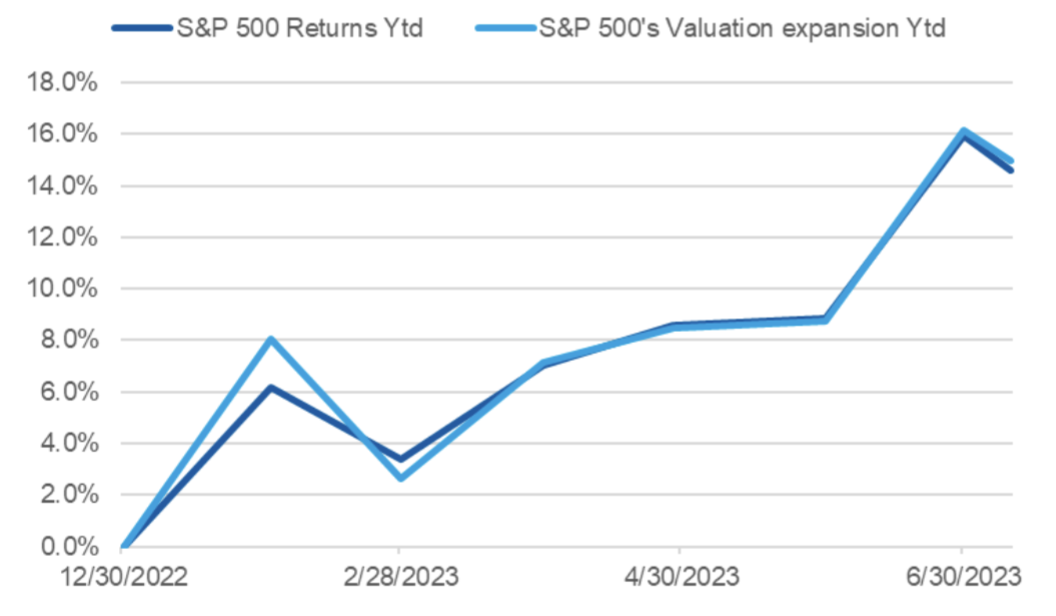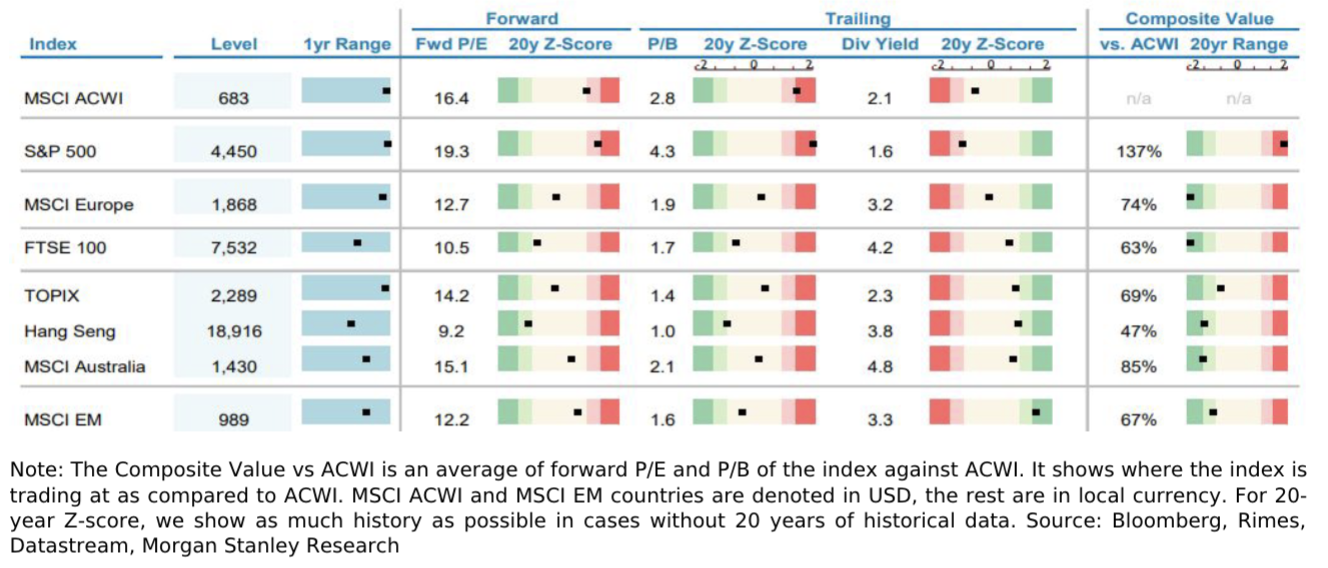How Morgan Stanley would invest $10,000 right now
In a world where active investing and stock picking is being preached more than ever, Alexandre Ventelon of Morgan Stanley Wealth Management has been doing the opposite. Ventelon has been adding to fixed income exposure over the last few months as well as passive investments like ETFs and listed funds.
In a recent episode of Livewire's flagship podcast The Rules of Investing, Ventelon discussed his idea of a passive investment-dominated portfolio with Livewire's Ally Selby.

Now, Ventelon is stepping up to Livewire's latest challenge - telling us how he would invest $10,000 of new capital in today's market.
Just like in the first piece with Elston Asset Management's Leon de Wet, Ventelon will be faced with the same two thematic questions around valuations and investment process. And as per the first example, Ventelon can nominate up to three assets. Finally, any cash which does not get used goes into a term deposit fetching 4% yield.

What's your read on market valuations at the moment?
The global economy has been more resilient than expected so far this year, supported by the continuous strength in the services sector offsetting the fall in manufacturing activity.
With a gradually slowing economy and inflation, the “soft-landing” scenario seems to be the most probable one in Morgan Stanley’s view. Nevertheless, deep yield curve inversion, combined with weak and falling leading indicators (e.g. Manufacturing PMI, US Leading Economic Indicator) still point to an elevated risk of a recession in the US and bode for caution.
We have been surprised by the extent of the rally in international equities so far this year but note the poor fundamentals with heavy US concentration (particularly in the last 3-4 months) which has generally been driven by valuation expansion (and not earnings improvement). In comparison, the performance of the overall Australian equity market has been relatively flat year to date.
Figure 1: US equity index performance has been largely driven by valuation expansion

With the 12-month forward price/earnings ratio for US equities currently in excess of 19x, while US 10-year Treasury yields trade at around 4%, the earnings yield for US equities is essentially in line with the US cash rate. Investors therefore must be very confident in the potential for earnings growth in the next 12 months to hold a preference for equities over cash (and government bonds to some extent).
This is not our view. Although the global equity rally could continue for a few more months, potentially supported by the prospect of less hawkish monetary policy, we foresee elevated risks or another substantial pull-back in equities over a six-month time horizon.
Therefore we see better value in bonds and cash over equities at this point. Within equities, while the large technology companies have performed strongly and have been benefiting from the Artificial Intelligence (AI) thematic, ex-US markets are currently more attractive as most of these regions still trade at the bottom of their relative valuation ranges.
Figure 2: Equity markets are relatively attractively priced outside of the US

How did you pick the assets you did for this experiment?
We have modelled a 3-security portfolio which provides the most attractive implementation of our current recommended positioning, blending our preferred bottom-up ideas with our top-down views. This portfolio is designed to potentially achieve superior risk-adjusted returns for investors over the next 12 months to the end of the current financial year.
We believe diversification will be essential this year. Admittedly, traditional diversification didn’t work that well in 2022 given the combination of a sharp rise in inflation along with Treasury yield increases impacting both bonds and equities – both correcting in double digits last financial year.
In light of our expectation for a “soft landing” around the world, but with risks tilted to the downside due to the uncertainties around the lagged impact of relatively swift monetary tightening, bonds could provide useful portfolio downside protection this year and we recommend a well-diversified portfolio between bonds, equities and alternative assets.
In addition, we have a preference for International over Australian assets in both equities and bonds, given Australia’s cycle is lagged compared to global peers. In Australia, inflation and rates will likely stay higher for longer and therefore may weigh further on domestic activity. Given the above outlook, we believe equity markets have mostly “front run” returns for the year, and we minimise our directional exposure.
With a more attractive starting point and good carry in bonds, appealing opportunities in the private equity secondaries markets as well as attractive valuations in the ex-US Developed stock Markets, we forecast our diversified portfolio can achieve mid to high single digit returns with limited volatility this financial year.
MSWM's $10,000 ideas
| Asset | Asset/ETF Code | Allocation |
Ironbark Royal London Diversified Global Share Fund |
DAM2442AU | 38% |
Hamilton Lane Global Private Assets Hedged AUD Fund |
PIM1015AU | 14.5% |
| ASX: VIF | 40.5% | |
| Cash (Term deposit, fetching 4% yield) | 7% |
The case for the Vanguard International Fixed Interest Index (AUD Hedged) ETF (ASX: VIF)
Government bond yields have “backed-up” recently, however we believe the market at present is focused incorrectly regarding key economic data - i.e. labour and growth, relative to inflation (which is slowing) - and in turn offering an attractive entry point to be positioned long duration. Mid-July will likely be an attractive entry point, in particular with regards to seasonality, the beginning of second quarter bank earnings results, along with more clarity on payrolls as well as inflation.
Essentially, we are buyers of duration after the recent “back-up” in yields. Government bonds remain our favourite long-only asset class with
- 10 year yields now around 4.0% in the US and Australia;
- risks skewed to the downside with key central banks soon reaching terminal rates and inflation moderating – in particular Morgan Stanley forecasts Australian 10 year Treasury yields at 3.60% in 12 months and the US equivalent at 3.30%;
- favourable asymmetry given in our base case we see inflation falling and key central banks pausing as providing a supportive environment for bonds. A “hard-landing scenario” with a stronger rise in unemployment would likely result in a deeper fall in yields, and thus potentially stronger bond returns.
Admittedly, the normalisation path for inflation and employment will likely not be a linear one, meaning that further volatility can be expected, but the carry in government bonds still offers a potential “cushion” for investors.
As discussed in our recent mid-year outlook, we swapped our preference from Australian to global government bonds given the lagged cycle in Australia. The disinflationary process is at an early stage domestically, with headline inflation peaking only in December 2022 versus June 2022 in the US. More importantly, recent data on productivity, core inflation and employment will likely support the Reserve Bank of Australia raising rates further. Morgan Stanley expects a terminal rate of 4.6% although risks are clearly skewed to the upside and we don’t expect any rate cut before August of next year (versus March in the US).
Our preferred instrument for exposure in fixed income is the Vanguard International Fixed Interest Index (AUD Hedged) ETF. VIF tracks the Bloomberg Barclays Global Treasury Scaled Index (AUD Hedged). VIF’s duration is approximately ~8.5 years and it has an investment grade credit quality.
VIF is our preferred ETF in this sub-asset class due to its tighter spreads, large funds under management as well as better risk metrics than the alternative ETFs which are available.
The case for the Ironbark Royal London Diversified Global Share Fund
The recent rebound in equities has mostly been associated with the US market this year, and particularly AI-related stocks. With relatively strong recent equity market performance and valuation dislocations, we believe the current environment is still more conducive for active management over passive. As discussed above, we expect better performance from offshore markets this year, largely driven by ex-US equity markets, against relatively flat expectations for Australian stocks amid a deteriorating consumer backdrop.
The Ironbark Royal London Diversified Global Share Fund invests in global equities utilising a fundamental bottom-up stock selection strategy which identifies companies based on criteria unique to their position in the “Corporate Life Cycle”.
The Fund combines qualitative analysis and quantitative screening to construct a benchmark-aware, low tracking error portfolio of around 150 to 250 securities.
The Fund is our preferred International Equities – Large Core (Diversified) strategy due to the experience and co-tenure of the lead portfolio managers, in addition to a differentiated investment process which benefits from proprietary analytical tools and a risk aware approach to portfolio construction. These factors have resulted in a consistent and balanced return profile.
The case for the Hamilton Lane Global Private Assets AUD Hedged Fund
In private equity, there are areas of opportunity, but investments made in the past few years remain vulnerable to mark-downs amid what likely will be a multi-year slowdown in fundraising ahead. Within private equity transaction types, we prefer secondaries to primary transactions. The backdrop for secondaries is favourable with public-market volatility and the relatively sluggish pace of private deal exit activity potentially leading to additional supply and larger discounts in the private secondary market.
Limited partners are leaning on the secondary market to rebalance their exposures, and general partners are using it to help restructure their funds.
The Hamilton Lane Global Private Assets AUD Hedged Fund invests in private market assets, allocating across direct equity, direct credit, secondary as well as opportunistic investments, and targeting a 10-12% p.a. return. The Hamilton Lane Global Private Assets AUD Fund benefits from an investment philosophy that seeks the higher quality and/or more defensive private market assets, a deeply resourced team of private market specialists, as well as a robust investment process including sensible portfolio construction, liquidity and risk management.
Although not a pure secondaries fund, it holds a substantial allocation to secondaries (i.e. around 45%) and also around 14% in private credit - an asset class we are also positive on.
Specialist advice from Morgan Stanley
Morgan Stanley Australia focuses on providing individuals and institutions with specialist strategic advice and then helping implement these strategies through superior investment execution. To learn more, please visit their website.
4 topics
1 stock mentioned
1 fund mentioned
3 contributors mentioned

